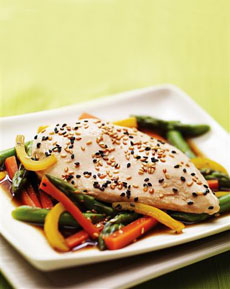 Boneless, skinless chicken breasts are easy to cook. Get the recipe for this Asian Chicken and Vegetables in Gingered Broth. Photo courtesy McCormick.com. Boneless, skinless chicken breasts are easy to cook. Get the recipe for this Asian Chicken and Vegetables in Gingered Broth. Photo courtesy McCormick.com.
September 2011
Last Updated August 2025
|
 |
Chicken Glossary: Chicken Terms
Page 2: Chicken Terms A & B
This is Page 2 of a seven-page chicken glossary. Click on the black links below to visit other pages. Check out almost 100 other food glossaries: details on all of your favorite foods.
This glossary is protected by copyright and cannot be copied in whole or in part.
ALEKTOROPHOBIA
Fear of chickens.
AMERICAN STANDARD OF PERFECTION
A book published by the American Poultry Association that describes each breed recognized by that organization. You can purchase it from the Association.
BABY CHICKEN or POUSSIN
A very young chicken, generally under 28 days of age and about a pound in weight, that’s ready to be eaten. Not to be confused with a chick.
|
BANTAM CHICKEN
A breed (or breeds) that is diminutive in size but not “miniature,” which refers to another type of chicken (most breeds of chicken have miniature variations). A bantam is one-fourth to one-half the size of a regular-sized chicken. The name comes from the city of Bantam, Indonesia, an area known for small chicken breeds. A true bantam does not have a larger counterpart, i.e., it is not a miniature version of a larger breed (nor is it a poussin, which is a young and therefore small chicken of any breed). There are some 13 true bantam breeds, including Belgian Bearded d’Anvers, Dutch, Japanese, Pekin, and Rosecomb. For smaller-sized breeds, also see Cornish game hen.
|
|
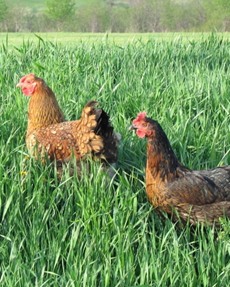
Alektorophobia? What’s to fear? Photo courtesy AnimalWelfareApproved.org. |
BARNYARD CHICKEN
A chicken of mixed breed (as a mutt is a dog of mixed breed).
|
BARBECUE or BARBEQUE or BBQ CHICKEN
There are many styles of barbecue the world over. But American barbecue has come to mean a meat (typically pork or chicken, or beef in the Southwest) covered in sweetened sauce (typically with a tomato paste base) and then grilled. Our word “barbecue” comes from barbacoa, the Spanish adaptation of the word barabicu from the Taino people of Guyana (a related term is jerky, derived from the Quechua [Inca language] term charqui). It referred to a rack made of wood on which meat is roasted over flames from wood or charcoal. While drying meat is the oldest method of preserving it (e.g., jerky), a smoky fire kept the insects at bay, which further helped in the preservation of the meat.
|
|
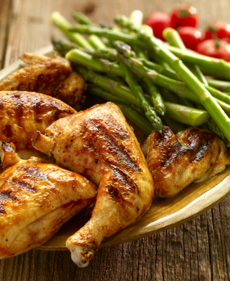
Barbecue chicken with asparagus. Photo by Eddie Berman | IST. |
Prior to home refrigeration,* meat from slaughtered animals had to be either cooked and eaten promptly or preserved by either salting or smoking. Over the centuries, this evolved into what we now call southern-style barbecue. But there is no one southern style: See the different types of barbecue sauce. The wooden racks were replaced with pits and smokehouses. And yes, the backyard barbecue grill evolved for homemade barbecue.
*In the millennia before the invention of the mechanical ice box, people kept food cold with ice and snow, saved during the winter months or brought down from mountaintops. The first “refrigeration” consisted of a hole dug into the ground and lined with wood or straw. It was then packed with snow and ice. Ice boxes existed from the mid-19th century, a response to the ice harvesting industry in America. The devices had hollow walls that were lined with tin or zinc and packed with insulation (cork, sawdust, straw, e.g.). A large block of ice was placed in a compartment near the top of the box, enabling cold air to circulate down into the storage compartment(s) below. Fresh ice was delivered by an iceman. While commercial refrigeration was available by the late 1800s, the home electric refrigerator didn’t arrive until 1930.
BEAK
The beak is the hard, protruding portion of a bird’s mouth; birds have beaks instead of lips. There is an upper beak and a lower beak.
BIDDY
A biddy is not a type of hen, but an affectionate word for any hen.
|
BONE-IN BREAST
The breast of the chicken is attached to the rib and split into two. The wings are removed. Many people prefer the deeper flavor from keeping the bone in while the meat cooks. This cut can be baked, deep-fried, or grilled.
BONELESS BREAST or BONELESS SKINLESS BREAST or BREAST CUTLET or BREAST FILLET
The most convenient cut for many recipes is a boneless, skinless breast. This breast can also be split in half to make smaller portions. Then, it is known as a split breast. Some people refer to a boneless breast—whole or split—as a cutlet. However, a cutlet is a thinner cut of the breast, also known as the tender or tenderloin (see cutlet). Whatever the boneless, skinless breast cut, it is most often breaded and/or sautéed. It can also be further baked, as with Chicken Parmigiana. The cut can also be baked and sliced for salad or sandwiches.
|
|
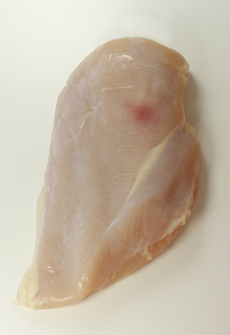
A skinless, boneless breast of chicken. Photo by Elvira Kalviste | THE NIBBLE. |
|
BREAST
The breast portion of the chicken is the white meat top portion of the chicken, minus the wing. (With the wing, it is known as the breast quarter.) It is available bone-in, boneless, skin-on, and skinless. See the chicken cuts chart.
BREAST HALVES
See boneless breast, above.
BREAST STRIPS
These are long strips of meat cut from the breast. They are typically deep-fried or sautéed and placed over greens for a warm chicken salad. While you can purchase ready-cut strips, it is easy to cut your own from a whole boneless breast or a cutlet.
|
|

Breast strips are perfect for salads. Photo courtesy McCormick.com. Get the recipe. |
|
BREAST QUARTER
The split breast of the chicken that includes the wing and portions of the back. It is all white meat. There are two breast quarters cut from each chicken.
BREED
A group of chickens that are like each other and different from other groups. Breed also refers to the mating of a rooster and a hen to obtain fertile eggs, which are used to breed more birds. The eggs we eat are unfertile eggs, which require no rooster.
|
|
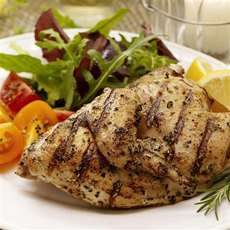
A breast quarter makes a great, flattened grilled chicken. Photo courtesy McCormick.com. Get the recipe. |
BREEDER
A breeder is a mature hen whose purpose is to produce fertile eggs that hatch new chickens. The term also refers to a person who breeds chickens.
|
BROILER or FRYER
Whole chickens are marketed by weight. A broiler is a whole, young, tender chicken, about seven weeks old. It weighs 3 to 4 pounds. Although you can roast a broiler, it is not as meaty as the older and larger roaster. It is a good size for smaller families and can be cut up and used in almost any recipe. In addition to broiling or frying, a broiler can be roasted, grilled or used to make chicken in the pot: chicken soup with large pieces of chicken. It’s also good for making stock. See also roaster and stewing hen.
|
|
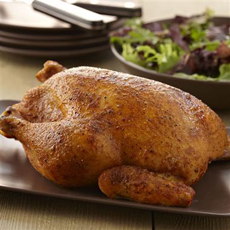
A broiler or fryer, above, is smaller than a roaster. Photo courtesy McCormick.com. Get the recipe. |
|
BUFFALO WINGS
Buffalo wings were invented in 1964 at the Anchor Bar in Buffalo. Co-owner Teressa Bellissimo fried the wings, covered them in her own hot sauce, and served them with a side of blue cheese and celery—because that’s what she had available. (Many popular dishes, including the Caesar salad and the Cobb salad, were invented because “that’s what was in the fridge.”) For the gourmet crowd, try this recipe for “deconstructed” buffalo wings. You can also make a Buffalo chicken pizza.
|
|
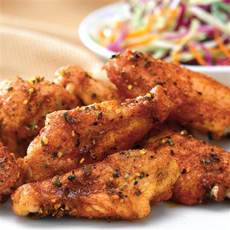
Buffalo wings. Photo courtesy McCormick.com. Get the recipe. |
Continue To Page 3: Chicken Definitions C
Go To The Article Index Above
This glossary is Lifestyle Direct, Inc. All rights reserved. Photos are the copyright of their respective owners.

|




 Boneless, skinless chicken breasts are easy to cook. Get the
Boneless, skinless chicken breasts are easy to cook. Get the 





